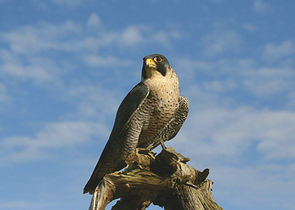Nature Conservation 1/2011 — 8. 4. 2011 — Nature and Landscape Management — Print article in pdf
Recovery of the Peregrine – A Successful Story of Nature Conservation or a Consequence of Spontaneou
– úspěch ochrany přírody, nebo důsledek

In the Czech Republic, the Peregrine (Falco peregrinus) numbers have dramatically changed. After its populations had collapsed across whole Europe in the mid-20thcentury, the raptor species totally disappeared from what is now the Czech Republic. Nevertheless, since the late 1980s, the Peregrine has been recolonizing its former nest sites there.
The positive trend has been continuing: the current numbers can be estimated at 50 breeding pairs in the Czech Republic. Since the early 1990s, intensive conservation measures have been implemented for the avian predator. Detailed monitoring has been aiming at finding all nest sites, factors threatening the species were analyzed and extensive measures to support the Peregrines population were implemented. All the activities were in detailes documented. Therefore, their real contribution for Peregrines population recovery can be consequently assessed. Direct guarding the nests against tourists and rock climbers was highly beneficial as well as furnishing above-ground transmission power lines and electricity pylons near nest sites with protective means, effectively preventing injuring and killing of birds by electric current. Introducing a detailed registration and marking of the individual birds in captivity was also of great importance, because it has helped to substantially reduce robbing of nests. As a part of supporting the newly establishing Peregrines population, reintroductions were also carried: particularly, young reared in captivity were released into the wild. Nevertheless, effectiveness of such measures has been low. Therefore, reintroductions may have influenced the Peregrines population recovery only in to a small extent in the Czech Republic. In the country, the development of the Peregrines population has been closely related to that in whole Central Europe. Conservation measures have accelerated the Peregrines remarkable comeback in the Czech Republic. Moreover, increasing in numbers of the falcon across the whole continent caused by the global ban on DDT has been a principal driver of the process.

